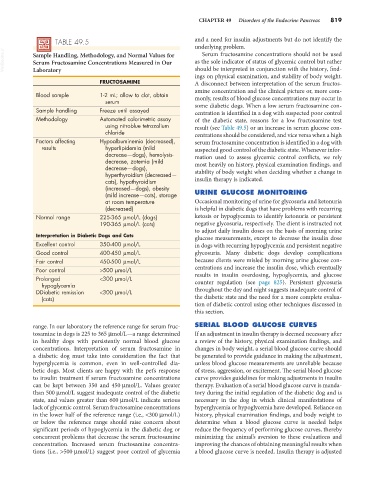Page 847 - Small Animal Internal Medicine, 6th Edition
P. 847
CHAPTER 49 Disorders of the Endocrine Pancreas 819
TABLE 49.5 and a need for insulin adjustments but do not identify the
underlying problem.
VetBooks.ir Sample Handling, Methodology, and Normal Values for as the sole indicator of status of glycemic control but rather
Serum fructosamine concentrations should not be used
Serum Fructosamine Concentrations Measured in Our
should be interpreted in conjunction with the history, find-
Laboratory
ings on physical examination, and stability of body weight.
FRUCTOSAMINE A disconnect between interpretation of the serum fructos-
amine concentration and the clinical picture or, more com-
Blood sample 1-2 mL; allow to clot, obtain
serum monly, results of blood glucose concentrations may occur in
Sample handling Freeze until assayed some diabetic dogs. When a low serum fructosamine con-
centration is identified in a dog with suspected poor control
Methodology Automated colorimetric assay of the diabetic state, reasons for a low fructosamine test
using nitroblue tetrazolium result (see Table 49.5) or an increase in serum glucose con-
chloride centrations should be considered, and vice versa when a high
Factors affecting Hypoalbuminemia (decreased), serum fructosamine concentration is identified in a dog with
results hyperlipidemia (mild suspected good control of the diabetic state. Whenever infor-
decrease—dogs), hemolysis- mation used to assess glycemic control conflicts, we rely
decrease, zotemia (mild most heavily on history, physical examination findings, and
decrease—dogs),
hyperthyroidism (decreased— stability of body weight when deciding whether a change in
cats), hypothyroidism insulin therapy is indicated.
(increased—dogs), obesity
(mild increase—cats), storage URINE GLUCOSE MONITORING
at room temperature Occasional monitoring of urine for glycosuria and ketonuria
(decreased) is helpful in diabetic dogs that have problems with recurring
Normal range 225-365 µmol/L (dogs) ketosis or hypoglycemia to identify ketonuria or persistent
190-365 µmol/L (cats) negative glycosuria, respectively. The client is instructed not
to adjust daily insulin doses on the basis of morning urine
Interpretation in Diabetic Dogs and Cats glucose measurements, except to decrease the insulin dose
Excellent control 350-400 µmol/L in dogs with recurring hypoglycemia and persistent negative
Good control 400-450 µmol/L glycosuria. Many diabetic dogs develop complications
Fair control 450-500 µmol/L because clients were misled by morning urine glucose con-
Poor control >500 µmol/L centrations and increase the insulin dose, which eventually
Prolonged <300 µmol/L results in insulin overdosing, hypoglycemia, and glucose
hypoglycemia counter regulation (see page 825). Persistent glycosuria
DDiabetic remission <300 µmol/L throughout the day and night suggests inadequate control of
(cats) the diabetic state and the need for a more complete evalua-
tion of diabetic control using other techniques discussed in
this section.
range. In our laboratory the reference range for serum fruc- SERIAL BLOOD GLUCOSE CURVES
tosamine in dogs is 225 to 365 µmol/L—a range determined If an adjustment in insulin therapy is deemed necessary after
in healthy dogs with persistently normal blood glucose a review of the history, physical examination findings, and
concentrations. Interpretation of serum fructosamine in changes in body weight, a serial blood glucose curve should
a diabetic dog must take into consideration the fact that be generated to provide guidance in making the adjustment,
hyperglycemia is common, even in well-controlled dia- unless blood glucose measurements are unreliable because
betic dogs. Most clients are happy with the pet’s response of stress, aggression, or excitement. The serial blood glucose
to insulin treatment if serum fructosamine concentrations curve provides guidelines for making adjustments in insulin
can be kept between 350 and 450 µmol/L. Values greater therapy. Evaluation of a serial blood glucose curve is manda-
than 500 µmol/L suggest inadequate control of the diabetic tory during the initial regulation of the diabetic dog and is
state, and values greater than 600 µmol/L indicate serious necessary in the dog in which clinical manifestations of
lack of glycemic control. Serum fructosamine concentrations hyperglycemia or hypoglycemia have developed. Reliance on
in the lower half of the reference range (i.e., <300 µmol/L) history, physical examination findings, and body weight to
or below the reference range should raise concern about determine when a blood glucose curve is needed helps
significant periods of hypoglycemia in the diabetic dog or reduce the frequency of performing glucose curves, thereby
concurrent problems that decrease the serum fructosamine minimizing the animal’s aversion to these evaluations and
concentration. Increased serum fructosamine concentra- improving the chances of obtaining meaningful results when
tions (i.e., >500 µmol/L) suggest poor control of glycemia a blood glucose curve is needed. Insulin therapy is adjusted

